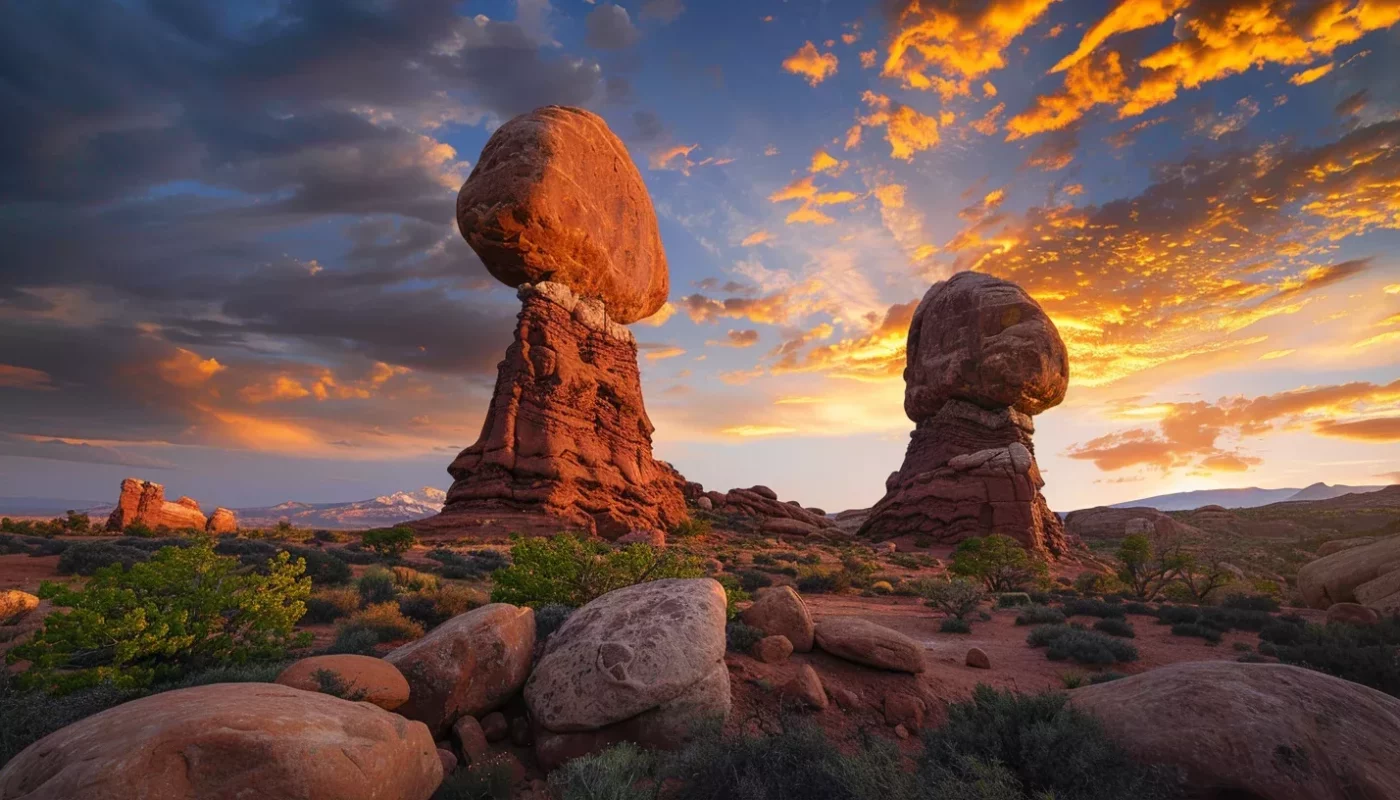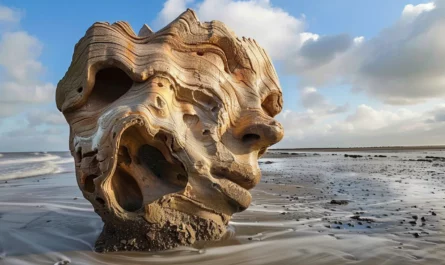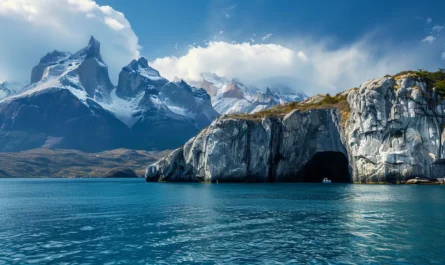Did you know some Balanced Rocks are as big as three school buses? These geological formations sit in seemingly delicate positions on other rocks, yet they’re incredibly stable. They’re a prime example of erosion geology, capturing attention in places like Arches National Park in Utah and the Garden of the Gods in Colorado.
These stunning formations draw in tourists, showing off nature’s incredible work. They’re not only beautiful to look at but also important for geologists. Scientists study these rocks to understand erosion and natural processes. It’s vital to protect these wonders for future generations. This article will explore the amazing Balanced Rock wonders and their geological importance.
The Geology Behind Balanced Rocks
The study of balanced rock formations comes from looking at erosion geology. This field shows us how such natural wonders are formed. For thousands of years, nature works to make these amazing rock structures.
The Role of Erosion
Erosion is key in creating balanced rocks. Rain, wind, and ice break down softer rocks. This leaves behind stronger rocks that seem to balance impossibly on smaller bases. They look like they’re defying gravity, thanks to erosion geology.
Formation Processes
To form balanced rocks, many natural processes work together. For example, Dakota Sandstone weathers into shapes like mushroom rocks. Over time, these actions lead to natural wonders in places all over the world.
We must protect these unique rocks. Scientists and conservationists study how balanced rocks form and erode. They aim to keep these wonders safe for everyone to enjoy in the future.
Famous Balanced Rocks in the United States
Across the United States, some Balanced Rocks are a big draw for people. They make geological tourism more interesting. These formations are special windows into our planet, and they are a treat for anyone who loves nature.
Balanced Rock, Utah
Balanced Rock stands proudly in Arches National Park. It’s a main highlight. It shows the amazing work of erosion over the years. Visitors get to see the beautiful sight of this rock amidst the vast desert setting.
Balanced Rock, Colorado
The Garden of the Gods in Colorado is home to an impressive Balanced Rock. It’s easy for people to get to. This Balanced Rock, amid red rocks, attracts lots of visitors. It’s perfect for photos and is near walking paths.
Big Bend National Park, Texas
In Texas’ Big Bend National Park, there is an awe-inspiring Balanced Rock. It shows how nature can shape our world. There are hikes to the Balanced Rock. They’re fun and teach about the geological history.
Saving these wonders is very important. We need to keep human impact low and watch for erosion. Teaching people about these places helps protect them. This way, Balanced Rocks can remain symbols of beauty and nature’s balance.
International Balanced Rock Formations
The world has many awe-inspiring balanced rock formations. They show nature’s artistry. Here are some famous ones from around the globe:
Kjeragbolten, Norway
Kjeragbolten in Norway is a huge boulder stuck in a mountain crevice. It’s above a deep abyss. This spot offers amazing views and a thrilling photo chance for daring visitors. It’s a hit with tourists worldwide.
Golden Rock, Burma
The Golden Rock in Burma, or Kyaiktiyo Pagoda, is important to Buddhists. It’s an amazing geological sight. A giant gold boulder balances on a cliff edge. It’s said to stay put because of Buddha’s hair. People across the world visit this site for its beauty and spiritual feel.
Devils Marbles, Australia
Australia’s Devils Marbles, or Karlu Karlu, are huge granite boulders. They’re spread out in a valley. Some boulders balance on top of each other, making a cool sight. These rocks amaze geologists and are important to local Aboriginal groups.
It’s critical to protect these sites for the future. Preserving them involves keeping trails in good shape, controlling tourist visits, and doing ongoing research. This helps safeguard these remarkable formations.
The Science of Precarious Rocks
Studying precarious rocks helps us understand their stability. These rocks stay in place despite being pushed by erosion. Scientists explore how these rocks, known as balanced rocks, keep stable. They have figured out why these rocks don’t fall, using research and models.
Recent studies in Big Bend National Park have provided valuable data. These Balanced Rock formations offer critical insights into seismic activities, acting as natural indicators of historical and potential future earthquake strengths.
Precarious rocks are amazing because they don’t erode easily. Unlike other formations that wear away, balanced rocks last longer. Their resistance to erosion is key to their survival.
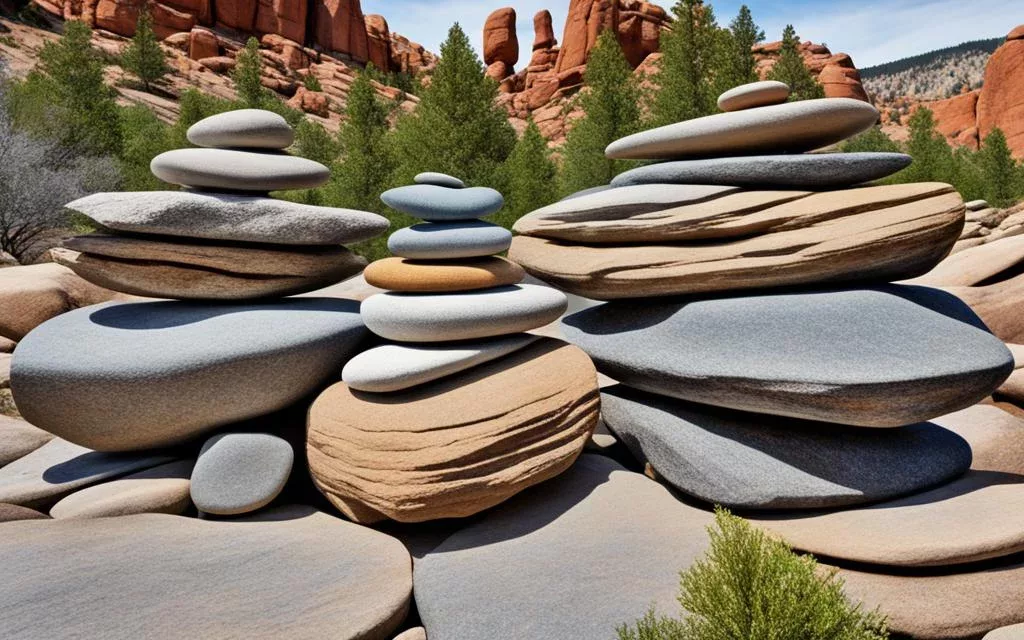
It’s important to protect these natural wonders. Knowing what keeps balanced rocks stable helps conservation work. We aim to guard these formations from harm caused by people or nature, ensuring they inspire us for years.
In short, learning about precarious rocks helps us keep them safe. By studying these formations, we get to enjoy their incredible beauty. This work allows them to stand strong against erosion.
Tourist Attractions Featuring Balanced Rocks
Tourist attractions with Balanced Rocks are breathtaking. They offer amazing views and unique formations. People from all over come to see them. These attractions are great for those who love nature, enjoy taking photos, or are seeking a spiritual journey. Arches National Park in Utah is famous for its Balanced Rock. It stands out in a landscape shaped by years of erosion.
Garden of the Gods in Colorado is also known for its balanced rocks. The rocks look like they might fall, but they stay in place. They show the strength of nature in shaping our planet.
Beyond the U.S., places like Burma’s Golden Rock add a touch of spirituality. It is a special rock that means a lot to people for religious reasons. It balances on a mountain, drawing visitors from everywhere. Norway’s Kjeragbolten is another spot that’s great for adventure and photos. A boulder hangs between two cliffs there, making it a natural wonder to see.
Protecting these balanced rocks is key. National parks and local groups worldwide work hard to keep them safe. This protects them for future generations to enjoy. By saving these places, we keep enjoying the amazing views and learn about our world’s natural beauty.
- Arches National Park, Utah
- Garden of the Gods, Colorado
- Burma’s Golden Rock
- Kjeragbolten, Norway
Impacts of Weather and Climate on Balanced Rocks
Balanced Rocks, nature’s gravity-defying wonders, face ongoing challenges due to weather and climate variations. It’s crucial to understand what affects their stability for preservation. This understanding can guide protective measures.
Effects of Temperature Changes
Temperature changes cause rocks to expand and contract. This erosion plays a big role in keeping Balanced Rocks stable. When it gets hot or cold, rocks can crack or existing cracks can get bigger. Over time, this makes Balanced Rocks likely to break or fall.
Role of Wind and Water
Wind and water shape geological formations slowly but surely. They carve unique shapes and wear rocks down. Wind smooths and polishes them. Water, through rain and ice, widens cracks. This shows the balance of creation and decay in geological formations.
Understanding these dynamics helps us appreciate the mechanisms at play and underscores the importance of climate-aware conservation practices.
We need to work on protecting these natural wonders from weather impacts. By studying temperature changes and erosion, we can find ways to keep these structures safe. This ensures they last for future generations to enjoy.
| Natural Forces | Impact on Balanced Rocks |
|---|---|
| Temperature Changes | Expansion and contraction leading to cracks and erosion |
| Wind | Smoothing and polishing rock surfaces |
| Water | Seeping into cracks and contributing to splitting |
The Symbolism and Cultural Significance of Balanced Rocks
Balanced Rocks are not just natural wonders. They also have deep meanings in many cultures. These rocks are linked with local legends, spiritual meanings, and myths. This adds to their mystery and beauty.
Spiritual and Religious Meanings
Many sacred places feature these amazing Balanced Rocks. For example, the Golden Rock in Burma is very sacred. It’s believed to be connected to Buddha’s hair. This attracts people from all over.
Such places are not just for worship. They also symbolize balance and faith. This shows the deep symbolism of Balanced Rocks in these sites.
Local Legends and Myths
Balanced Rocks play a big role in local stories. Many legends talk about gods, giants, and magical beings. They’re said to have shaped these rocks with their powers.
These stories are part of what makes these rocks special. They’re key to the culture and history of the places they’re in.
It’s also important to keep these sites safe. Protecting them helps keep their stories and meanings alive. This way, future generations can learn from these amazing natural sights and their stories.
Conservation Efforts for Balanced Rocks
Preserving balanced rocks is key to keeping nature in harmony. We must control human activity near these formations. For example, Acadia National Park took down 3,500 unapproved cairns in a year. This helped prevent hikers from getting lost.
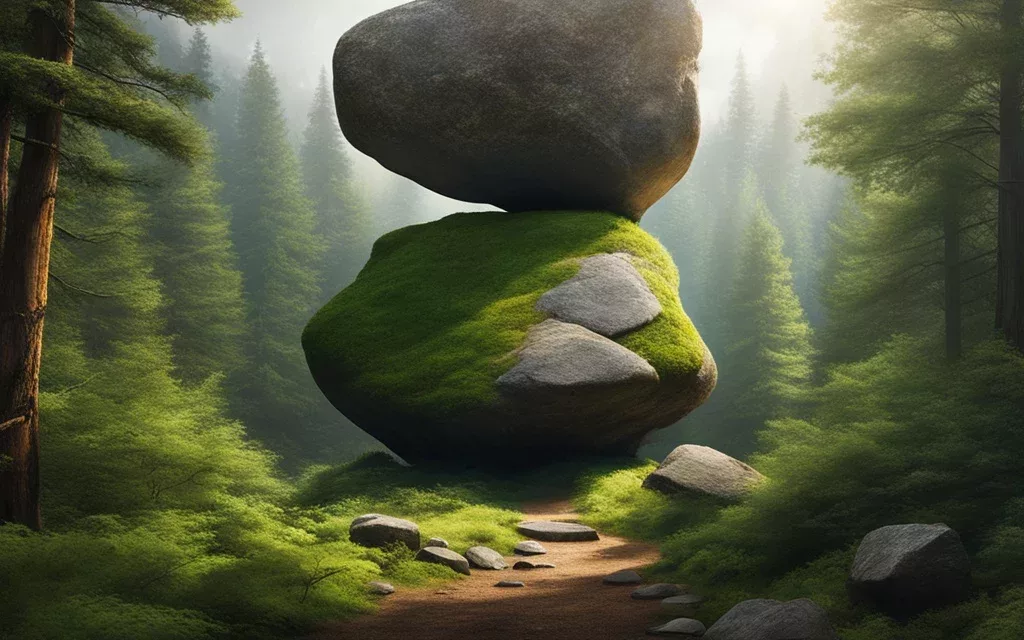
Since the 1990s, cairns have helped hikers find their way in National Parks. This practice keeps the landscape natural while supporting conservation. But, when non-experts stack rocks, it can harm the environment.
When people move rocks, it can upset fish homes. Without the rocks, fish eggs are easy targets for predators. Removing rocks also harms species that need cooler, shaded water. And it blocks mussels and water bugs from getting food and living normally.
“Rock stacks built by thousands of individuals worldwide contribute to ecological damage.”
Environmental groups teach people why it’s important to leave rocks in place. Moving rocks sends soil into streams, harming the water and living things. Altered stream layouts cause more erosion. This hurts the water’s health even more.
Conserving these rocks is not just about looks. For instance, Zimbabwe’s Chiremba Balancing Rocks are so iconic they appear on currency. They stand for balance and caring for natural wonders. Preserving these sites means they’ll last for many more years.
| Issue | Impact |
|---|---|
| Unauthorized Cairns | Confuse hikers, disrupt ecological balance |
| Fish Habitat Disruption | Increases egg vulnerability to predators |
| Sunlight Exposure | Harms cooler water species |
| Freshwater Mussels | Impacts food access |
| Aquatic Insects | Obstructs life cycles |
| Soil Displacement | Affects water quality, organisms |
| Increased Erosion | Disturbs ecological balance |
Environmental efforts focus on preventing damage. Educating people is crucial for the care of these natural beauties. We aim to keep them amazing for future generations.
Balanced Rock Hiking Trails in the U.S.
The U.S. has amazing Balanced Rock hiking trails for nature lovers. You can find great trails at Arches National Park and Garden of the Gods. These places show off incredible rock formations and offer awesome hiking experiences.
Arches National Park Trails
The Balanced Rock at Arches National Park is 9.2 miles from the visitor center. The hike around this huge rock is short, just 0.3 miles, and takes 15-30 minutes. Though not tall, Balanced Rock’s size and weight are impressive. Visitors can’t climb Balanced Rock or bring dogs to protect this spot. The area has a picnic spot and toilet for a comfortable visit.
Garden of the Gods Trails
In Colorado, the Garden of the Gods has beautiful Balanced Rock hiking trails too. These trails take you past amazing rock shapes. Hikers should take care not to disturb these natural formations.
- Check out the amenities near Balanced Rock in Arches National Park, like picnic tables with views of Salt Valley.
- Evening hikes are great for stargazing and night photos, thanks to low light pollution.
- Use cairns as guides but don’t make new ones, to keep the trails natural.
- Remember the story of Balanced Rock’s fallen sibling in 1975-76, showing nature’s constant change.
Whether at Arches National Park or Garden of the Gods, these Balanced Rock hiking trails promise fun exercise and breathtaking views.
Photographing Balanced Rocks
Photographing balanced rocks blends nature’s magic with the art of capturing moments. These rock formations look like they’re defying gravity. They make for stunning photo subjects.
Best Times of Day for Photography
The timing is key for great photos of balanced rocks. The golden hour brings out the best in these formations. It gives a soft, warm light that highlights the rocks’ textures and shapes. Early mornings and late afternoons also provide the perfect light. They add interesting shadows to your photos, making them more eye-catching.
Top Locations for Stunning Shots
Some places are famous for their balanced rocks, making them great for photos. In the U.S., check out Arches National Park in Utah and Colorado’s Garden of the Gods. For adventures abroad, Norway’s Kjeragbolten and the Devils Marbles in Australia are must-sees. These spots, with the right photography tricks, can turn a simple photo into a work of art.
| Location | Best Time of Day | Reason |
|---|---|---|
| Arches National Park, Utah | Golden Hour | Dramatic lighting enhances rock textures |
| Garden of the Gods, Colorado | Late Afternoon | Long shadows accentuate formations |
| Kjeragbolten, Norway | Early Morning | Minimal crowds for unobstructed views |
| Devils Marbles, Australia | Sunrise | Warm hues create vivid colors |
By using these photography tips natural wonders, photographers can truly showcase the beauty and essence of photographing balanced rocks in amazing scenic photography locations around the world.
Conclusion
Balanced Rocks are stunning examples of what nature can do. They are like art made by the earth. These rocks form over time, shaped by erosion and the weather. This shows us how the earth changes and creates amazing sights.
These rocks are more than just beautiful. They mean a lot to many cultures. In Burma, the Golden Rock is sacred. In other places, they represent balance and resilience. Their meaning goes deep, touching hearts and minds across the world.
It’s important to keep these rocks safe for the future. Places like Arches National Park and Zimbabwe’s Chiremba Balancing Rocks need protection. This helps us preserve these special places. It keeps the balance they stand for safe. By doing this, we keep our bond with nature strong. We also keep sharing and loving these natural wonders.

